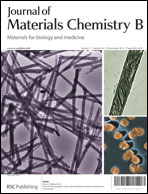“Paintable” 3D printed structures via a post-ATRP process with antimicrobial function for biomedical applications
Abstract
3D printing technology is becoming a new attractive manufacturing approach in medical and biomedical fields. In this paper, 3D printed structures were “painted” with functional polymer brushes via atom transfer radical polymerization (ATRP) to achieve antimicrobial properties for biomedical applications. An ATRP initiator was added into 3D printing ink without affecting the optical and polymerization properties. After the 3D printing process using the functionalized ink, the surface readily binds with the Br terminated initiator for the following surface modification. Moreover, since the initiator exists in the bulk material and thus the entire printed structure, if needed, any damaged surface can be easily re-painted with a single step of the ATRP polymerization process. To demonstrate the technique, 3-sulfopropyl methacrylate potassium salt (SPMA) was grafted onto the surface and the adhesion of bacteria was significantly reduced. In addition, the functionalized surface can also inhibit the growth of bacteria on the surface. Enabling new functions of the printed structures, the developed technique has significantly expanded the capability of 3D printing technology for biomedical applications.


 Please wait while we load your content...
Please wait while we load your content...